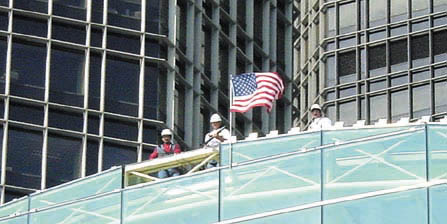Unions, contractors get prepared for biological hazards
Date Posted: November 9 2001
Union members were a major help in the search and cleanup effort in the aftermath of the terrorist attack of World Trade Center towers. Here in Michigan, they're getting themselves ready to be involved in the cleanup of another terrorist threat: biological weapons.
Members of Asbestos Abatement Workers Regional Local 207, the Michigan Laborers District Council and their contractors already have a ready supply of workers trained and willing to clean up after a biological attack, and more are in the process of being trained.
"It's a natural fit for us," said Rand Environmental owner Larry Mates, who is readying his company to perform such clean-up work. "If the time comes when this type of work needs to be done, we're going to be in a position to accommodate our customers. We're in this for the long-term."
Mates is getting the process rolling by advertising his company's services in Crain's Detroit Business and in this publication, and is getting the attention of businesses like Rand's existing customer base of Daimler-Chrysler, Detroit Edison, and General Motors.
State and federal laws currently have training and certification requirements for workers who toil in asbestos and lead abatement, as well as a newer area, mold remediation. The unions and the contractors provide the training and the physical examinations to get the certification, as well as fitting for equipment like the suits and respirators.
An additional 40 hours of training gains a worker a license to handle "hazardous materials," an all-encompassing term that includes biological hazards. Local 207 Business Manager Tom Dyl said there are currently about 100 members who have the hazardous material certification, with another 50 in the training pipeline around the regional local's Midwest District Council. He said this training does not apply to clean-up of hazardous waste sites that are mandated by the Environmental Protection Agency.
Dyl said the biological training includes enhanced respirator equipment, more worker education, as well as preparation in how to dispose of the hazardous materials. These days, anthrax is the most notorious hazardous material, but the 40-hour training covers the clean-up of a number of other toxins.
"Our members have no trepidation about working with those hazardous materials," Dyl said. "Once you put those suits on, the air you breathe is safer than the air you'd breathe in your house."
John Luckett, the environmental representative for the Michigan Laborers agreed that "it's not much of a jump" from asbestos or mold remediation, to cleaning up biological hazards. "It really doesn't matter what you're removing, you're following pretty much the same procedures," he said.
There are between 150 and 300 laborers working in the abatement industry, and Luckett said about 35 are trained and "ready to go when needed" to the East Coast to help with hazardous material remediation in post offices or wherever else they may be needed.
In the case of the anthrax attacks against the U.S. Capitol, the clean-up is currently being conducted by military and federal health officials. "But private companies - which never saw a market in bioterrorism cleanups - may seek a piece of the action," the Wall Street Journal said.
Terrorist-delivered biological weapons may never reach this part of the country - but then again, it could spread via the U.S. mail or by any other means to America's heartland at any time. Union labor and their contractors are in the process of getting ready to help in the clean up.

IT'S NOT MUCH of a jump for hazardous material abatement workers to toil in the field of cleaning up biological materials. Shown here setting up an asbestos abatement project are laborers Robert Priest (Local 1076) and Mike Senterfit (Local 334).
